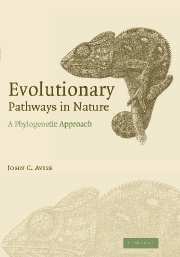Book contents
- Frontmatter
- Contents
- Preface
- Acknowledgments
- 1 Introduction
- 2 Anatomical structures and morphologies
- 3 Body colorations
- 4 Sexual features and reproductive lifestyles
- 5 More behaviors and ecologies
- 6 Cellular, physiological, and genetic traits
- 7 Geographical distributions
- Epilog
- Appendix: a primer on phylogenetic character mapping
- Glossary
- References and further reading
- Index
7 - Geographical distributions
Published online by Cambridge University Press: 18 December 2009
- Frontmatter
- Contents
- Preface
- Acknowledgments
- 1 Introduction
- 2 Anatomical structures and morphologies
- 3 Body colorations
- 4 Sexual features and reproductive lifestyles
- 5 More behaviors and ecologies
- 6 Cellular, physiological, and genetic traits
- 7 Geographical distributions
- Epilog
- Appendix: a primer on phylogenetic character mapping
- Glossary
- References and further reading
- Index
Summary
Geography is another “trait” that can be subjected to PCM. In this case, the geographical arrangements of species (i.e. their character states with respect to space) are plotted onto species' phylogenies as estimated from molecular or other genetic data. The usual intent is to reciprocally illuminate the geological histories of landforms (or bodies of water) and the evolutionary histories of organismal lineages that have inhabited those areas. For example, about three million years ago the Isthmus of Panama gradually emerged above sea level, creating a land bridge that facilitated movements of terrestrial organisms between North and South America and effectively blocking genetic interchanges between marine populations in the tropical Atlantic versus Pacific Oceans. The phylogenetic impacts of this geophysical event can be studied today by comparing molecular patterns among living species in that part of the world.
Strictly speaking, geographic features do not evolve (only biological entities do), but they certainly change through time in response to geological and other physical forces of the planet, and they certainly can leave major evolutionary genetic footprints on conspecific populations, closely related species, and broader taxonomic groups. Furthermore, the evolutionary pathways marked by these phylogenetic footprints often lead researchers to new discoveries about cryptic species or otherwise unrecognized biodiversity hotspots that can be highly important in conservation efforts.
Afrotheria theory
For several decades, geologists have known that continents drift about the surface of the planet, sometimes moving apart and sometimes colliding with one another like bumper cars in a circular arena.
- Type
- Chapter
- Information
- Evolutionary Pathways in NatureA Phylogenetic Approach, pp. 190 - 220Publisher: Cambridge University PressPrint publication year: 2006



